History of nuclear weapons testing
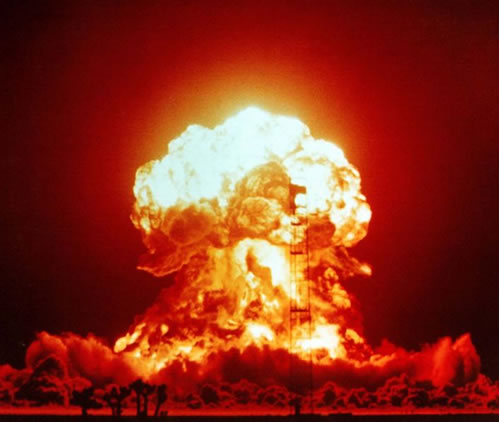
The first nuclear weapon was detonated as a test by the United States at the Trinity site on July 16, 1945, with a yield approximately equivalent to 20kilotons. The first hydrogen bomb, codenamed “Mike“, was tested at the Enewetak atoll in the Marshall Islands on November 1 (local date) in 1952, also by the United States. The largest nuclear weapon ever tested was the “Tsar Bomba” of the Soviet Union at Novaya Zemlya on October 30, 1961, with an estimated yield of around 50 megatons.
In 1963, all nuclear and many non-nuclear states signed the Limited Test Ban Treaty, pledging to refrain from testing nuclear weapons in the atmosphere, underwater, or in outer space. The treaty permitted underground nuclear testing. France continued atmospheric testing until 1974, China continued up until 1980.
Underground tests in the United States continued until 1992 (its last nuclear testing), the Soviet Union in 1990, the United Kingdom in 1991, and both China and France in 1996. After signing the Comprehensive Test Ban Treaty in 1996 (which has as of 2011 not yet entered into force), all of these states have pledged to discontinue all nuclear testing. Non-signatories India and Pakistan last tested nuclear weapons in 1998.
The most recent nuclear test was announced by North Korea on May 25, 2009.
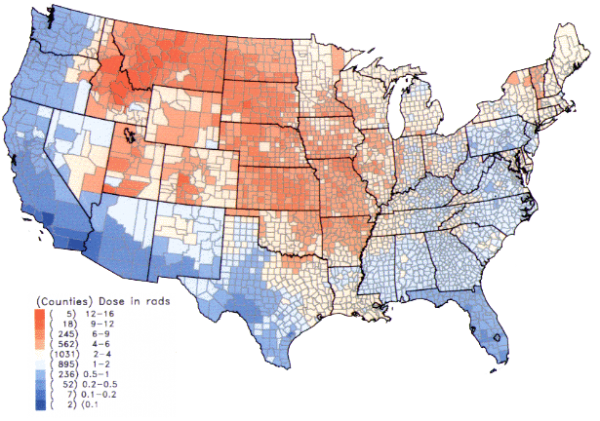
The nuclear powers have conducted more than 2,000 nuclear test explosions (numbers are approximated, as some test results have been disputed):
 United States: 1,054 tests by official count (involving at least 1,151 devices, 331 atmospheric tests), most at Nevada Test Site and the Pacific Proving Grounds in the Marshall Islands, with 10 other tests taking place at various locations in the United States, includingAmchitka Alaska, Colorado, Mississippi, and New Mexico ( Nuclear weapons and the United States)
United States: 1,054 tests by official count (involving at least 1,151 devices, 331 atmospheric tests), most at Nevada Test Site and the Pacific Proving Grounds in the Marshall Islands, with 10 other tests taking place at various locations in the United States, includingAmchitka Alaska, Colorado, Mississippi, and New Mexico ( Nuclear weapons and the United States) Soviet Union: 715 tests (involving 969 devices) by official count,most at Semipalatinsk Test Site and Novaya Zemlya, and a few more at various sites in Russia, Kazakhstan, Turkmenistan, and Ukraine.
Soviet Union: 715 tests (involving 969 devices) by official count,most at Semipalatinsk Test Site and Novaya Zemlya, and a few more at various sites in Russia, Kazakhstan, Turkmenistan, and Ukraine. France: 210 tests by official count (50 atmospheric, 160 underground), 4 atomic atmospheric tests a C.E.S.M. near Reggane, 13 atomic underground tests at C.E.M.O. near In Ekker in the then French Algerian Sahara, and nuclear atmospheric tests at Fangataufa and nuclear undersea tests Moruroa in French Polynesia. Additional atomic and chemical warfare tests took place in the secret base B2-Namous, near Ben Wenif, other tests involving rockets and missiles at C.I.E.E.S, near Hammaguir, both in the Sahara.
France: 210 tests by official count (50 atmospheric, 160 underground), 4 atomic atmospheric tests a C.E.S.M. near Reggane, 13 atomic underground tests at C.E.M.O. near In Ekker in the then French Algerian Sahara, and nuclear atmospheric tests at Fangataufa and nuclear undersea tests Moruroa in French Polynesia. Additional atomic and chemical warfare tests took place in the secret base B2-Namous, near Ben Wenif, other tests involving rockets and missiles at C.I.E.E.S, near Hammaguir, both in the Sahara. United Kingdom: 45 tests (21 in Australian territory, including 9 in mainland South Australia at Maralinga and Emu Field, some at Christmas Island in the Pacific Ocean, plus many others in the United States as part of joint test series)
United Kingdom: 45 tests (21 in Australian territory, including 9 in mainland South Australia at Maralinga and Emu Field, some at Christmas Island in the Pacific Ocean, plus many others in the United States as part of joint test series)  China: 45 tests (23 atmospheric and 22 underground, at Lop Nur Nuclear Weapons Test Base, in Malan, Xinjiang)
China: 45 tests (23 atmospheric and 22 underground, at Lop Nur Nuclear Weapons Test Base, in Malan, Xinjiang) India: 6 underground tests (including the first one in 1974), at Pokhran
India: 6 underground tests (including the first one in 1974), at Pokhran Pakistan: 6 underground tests, at Ras Koh Hills, Chagai District and Kharan Desert, Kharan District in Balochistan Province
Pakistan: 6 underground tests, at Ras Koh Hills, Chagai District and Kharan Desert, Kharan District in Balochistan Province
 North Korea: two tests at Hwadae-ri
North Korea: two tests at Hwadae-ri
Additionally, there may have been at least three alleged but unacknowledged nuclear explosions (see list of alleged nuclear tests). Of these, the only one taken seriously as a possible nuclear test is the Vela Incident, a possible detection of a nuclear explosion in the Indian Ocean in 1979.
Nuclear use locations world map
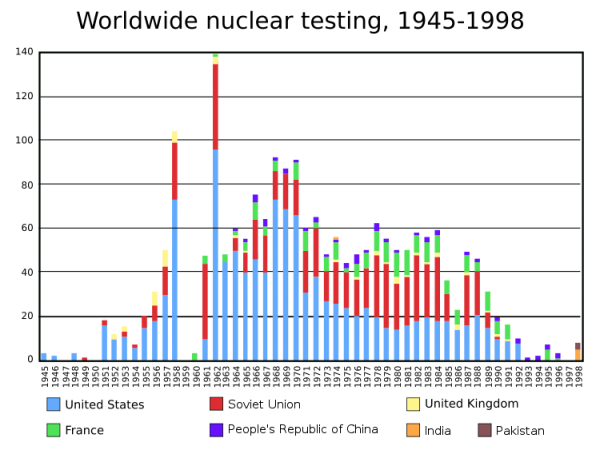
Compensation for victims
Over 500 atmospheric nuclear weapons tests were conducted at various sites around the world from 1945 to 1980. As public awareness and concern mounted over the possible health hazards associated with exposure to the nuclear fallout, various studies were done to assess the extent of the hazard. A Centers for Disease Control and Prevention/ National Cancer Institute study claims that nuclear fallout might have led to approximately 11,000 excess deaths, most caused by thyroid cancer linked to exposure to iodine-131. (Wikipedia)
- United States: As of March 2009, the U.S. is the only nation that compensates nuclear test victims. Since the Radiation Exposure Compensation Act of 1990, more than $1.38 billion in compensation has been approved. The money is going to people who took part in the tests, notably at the Nevada Test Site, and to others exposed to the radiation.
- France: In March 2009, the French Government offered to compensate victims for the first time and legislation is being drafted which would allow payments to people who suffered health problems related to the tests. The payouts would be available to victims’ descendants and would include Algerians, who were exposed to nuclear testing in the Sahara in 1960. However, victims say the eligibility requirements for compensation are too narrow.
- Britain: There is no formal British government compensation program. However, nearly 1,000 veterans of Christmas Island nuclear tests in the 1950s are planning to sue the Ministry of Defense for negligence. They say they suffered health problems and were not warned of potential dangers before the experiments.
- Russia: Decades later, Russia offered compensation to veterans who were part of the 1954 Totsk test. However, there was no compensation to civilians sickened by the Totsk test. Anti-nuclear groups say there has been no government compensation for other nuclear tests.
- China: China has undertaken highly secretive atomic tests in remote deserts in a Central Asian border province. Anti-nuclear activists say there is no known government program for compensating victims.
It is estimated that the total yield of all the atmospheric nuclear weapons tests conducted is 438 megatons. That’s equivalent to 29,200 Hiroshima size bombs. In the 36 years between 1945 and 1980 when atmospheric testing was being conducted this would have been equivalent to exploding a Hiroshima size bomb in the atmosphere every 11 hours.
Approximately 3,830 kilograms of plutonium has been left in the ground as a result of all underground nuclear testing and some 4,200 kilograms of plutonium has been discharged into the atmosphere as a result of atmospheric nuclear testing.
Wherever nuclear weapons testing has occurred for whatever reasons there have been environmental problems. Radioactivity has leaked into the environment from underground nuclear tests, large areas of land are uninhabitable as a result of atmospheric and underground nuclear testing, and indigenous people, their children and their children’s children’s health and livelihoods have been affected by nuclear weapons tests. (Greenpeace No.Nukes)
http://blip.tv/ctbtomedia/1945-1998-by-isao-hashimoto-japan-2003-1671472

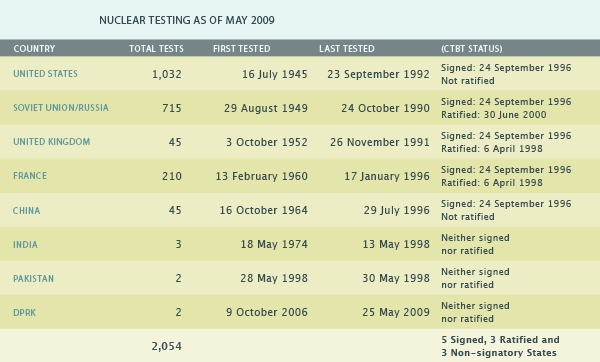
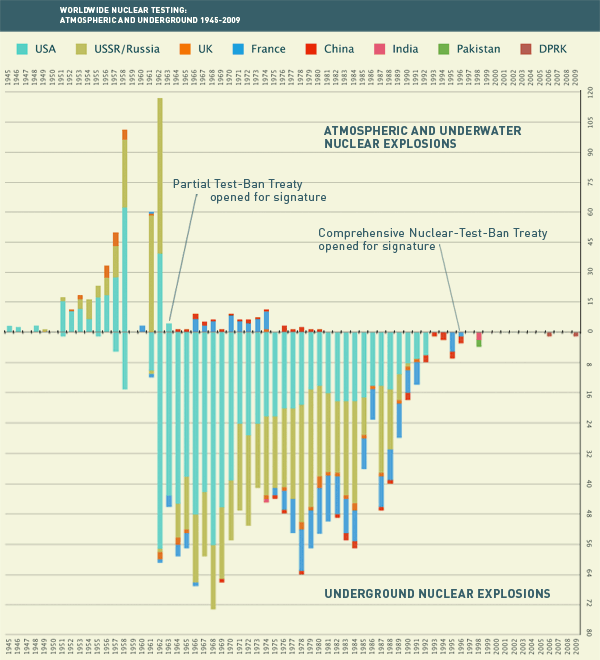
Commenting rules and guidelines
We value the thoughts and opinions of our readers and welcome healthy discussions on our website. In order to maintain a respectful and positive community, we ask that all commenters follow these rules.